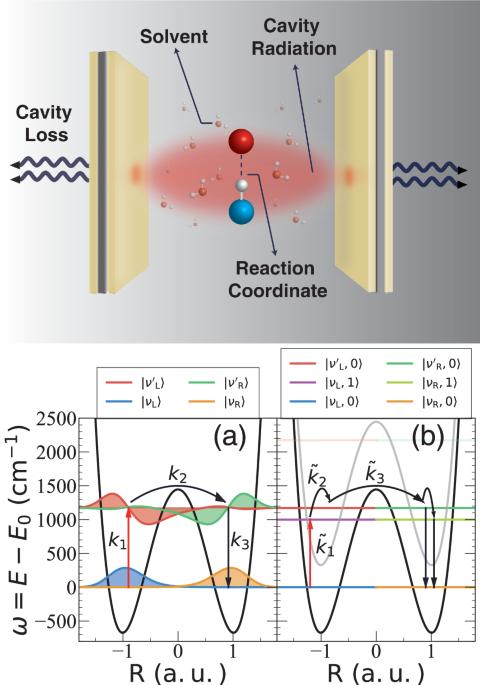振动强耦合增强极化子化学共振理论及光子模式寿命的作用
IF 9.6
Q1 MATERIALS SCIENCE, MULTIDISCIPLINARY
引用次数: 0
摘要
最近的实验证明,振动强耦合(VSC)机制下的极化子可以改变化学反应活性。在此,我们提出了单分子与光腔耦合时的 VSC 修正速率常数的完整理论,并理解了光子模式寿命的作用。解析表达式显示了一种尖锐的共振行为,当空腔频率与振动频率相匹配时,速率常数达到最大值。该理论解释了为什么 VSC 速率常数的变化与腔外振动的光学光谱非常相似。此外,我们还讨论了 VSC 修正速率常数的温度依赖性。分析理论与针对所有探究机制的精确分层运动方程(HEOM)数值模拟结果十分吻合。最后,我们讨论了在法布里-佩罗腔内考虑面内动量时的法线入射共振条件。极化子化学,即分子振动与光学微腔内量子化辐射模式的耦合,为改变化学反应活性提供了一种前景广阔的策略。在此,作者提供了振动强耦合如何改变不同空腔状态下化学反应速率的综合理论。本文章由计算机程序翻译,如有差异,请以英文原文为准。

Resonance theory of vibrational strong coupling enhanced polariton chemistry and the role of photonic mode lifetime
Recent experiments demonstrate polaritons under the vibrational strong coupling (VSC) regime can modify chemical reactivity. Here, we present a complete theory of VSC-modified rate constants when coupling a single molecule to an optical cavity, where the role of photonic mode lifetime is understood. The analytic expression exhibits a sharp resonance behavior, where the maximum rate constant is reached when the cavity frequency matches the vibration frequency. The theory explains why VSC rate constant modification closely resembles the optical spectra of the vibration outside the cavity. Further, we discussed the temperature dependence of the VSC-modified rate constants. The analytic theory agrees well with the numerically exact hierarchical equations of motion (HEOM) simulations for all explored regimes. Finally, we discussed the resonance condition at the normal incidence when considering in-plane momentum inside a Fabry-Pérot cavity. Polariton chemistry, namely the coupling of molecular vibrations to quantized radiation modes inside an optical microcavity, offers a promising strategy to modify chemical reactivities. Here, the authors provide a comprehensive theory of how vibrational strong coupling modifies chemical reaction rates in different cavity regimes.
求助全文
通过发布文献求助,成功后即可免费获取论文全文。
去求助
来源期刊

Communications Materials
MATERIALS SCIENCE, MULTIDISCIPLINARY-
CiteScore
12.10
自引率
1.30%
发文量
85
审稿时长
17 weeks
期刊介绍:
Communications Materials, a selective open access journal within Nature Portfolio, is dedicated to publishing top-tier research, reviews, and commentary across all facets of materials science. The journal showcases significant advancements in specialized research areas, encompassing both fundamental and applied studies. Serving as an open access option for materials sciences, Communications Materials applies less stringent criteria for impact and significance compared to Nature-branded journals, including Nature Communications.
 求助内容:
求助内容: 应助结果提醒方式:
应助结果提醒方式:


